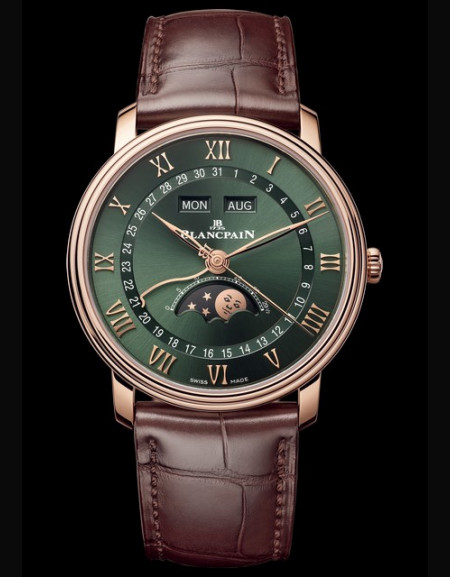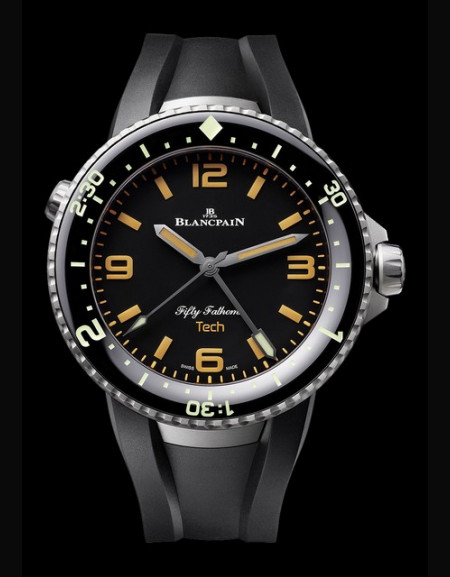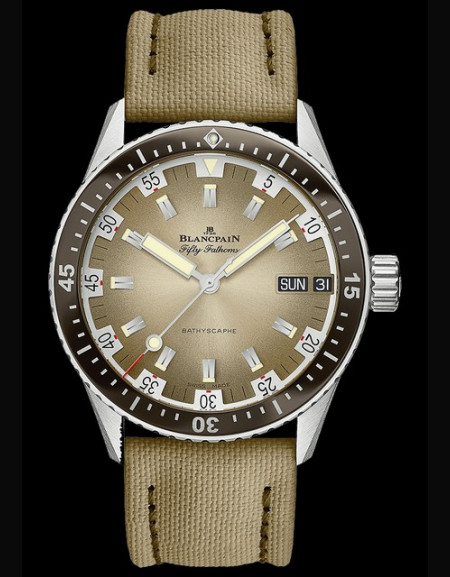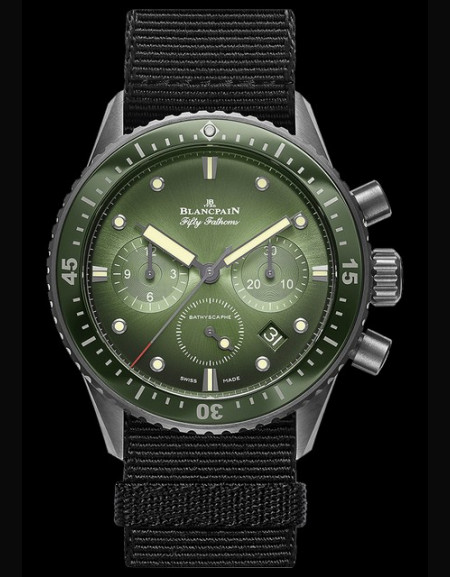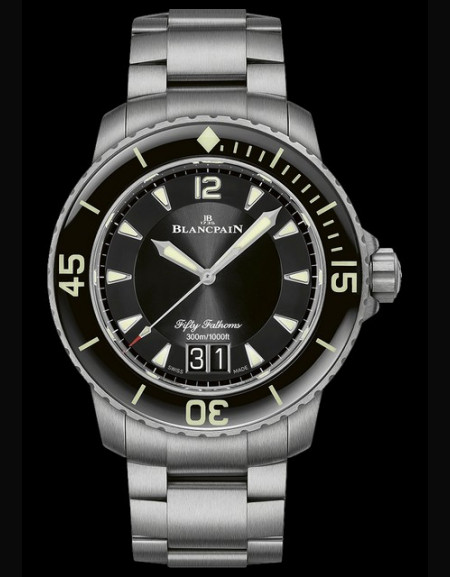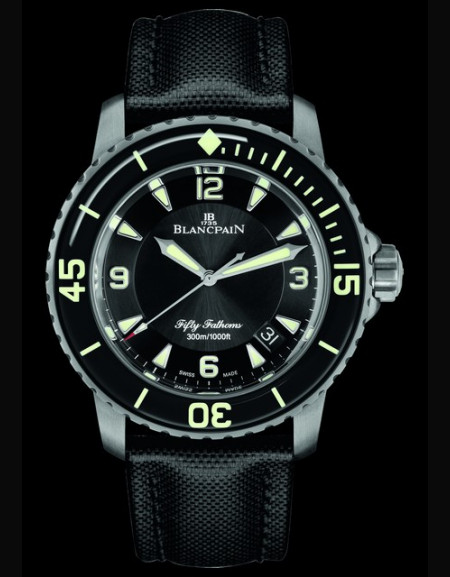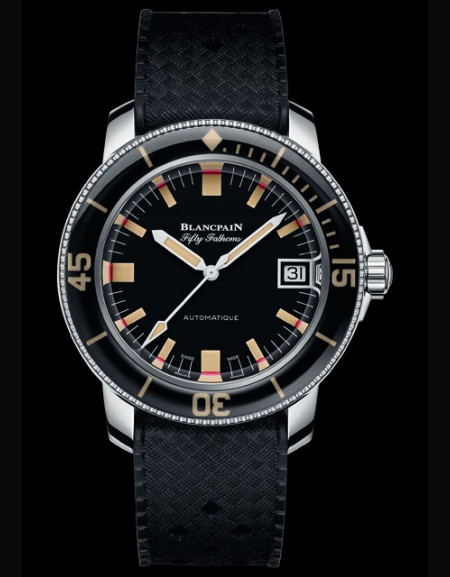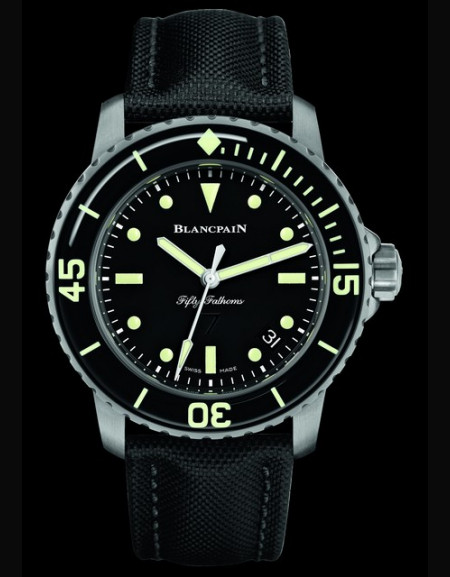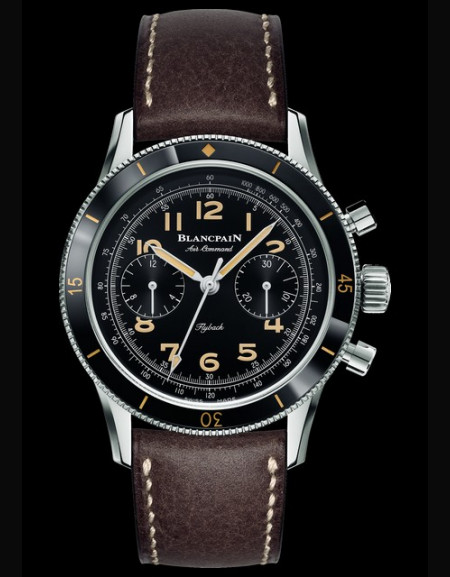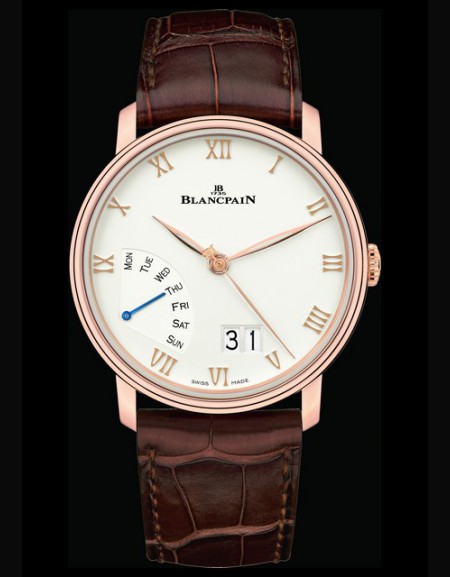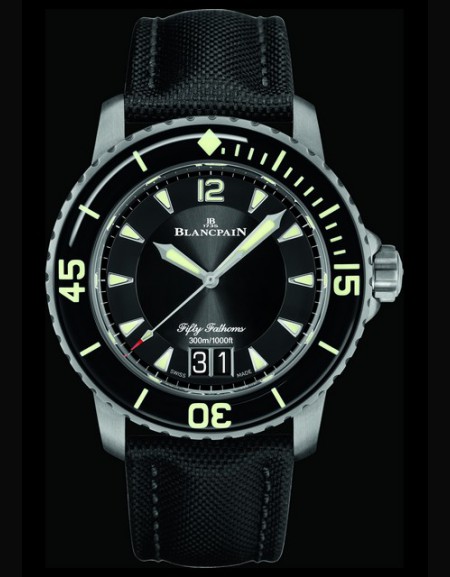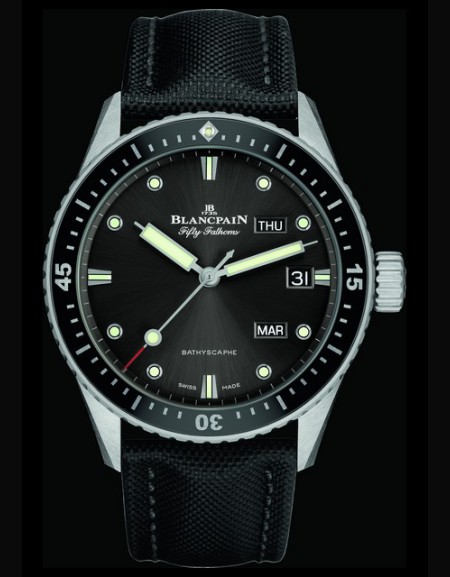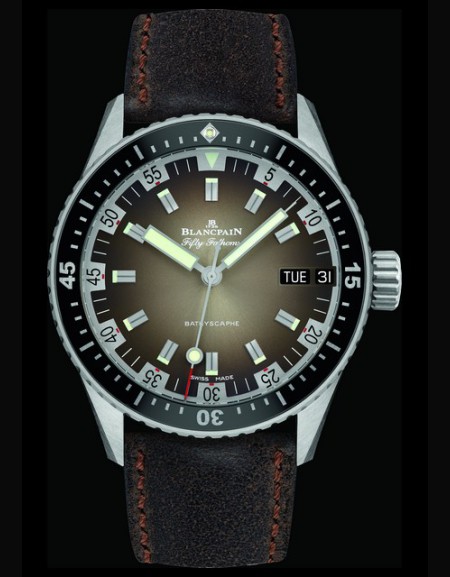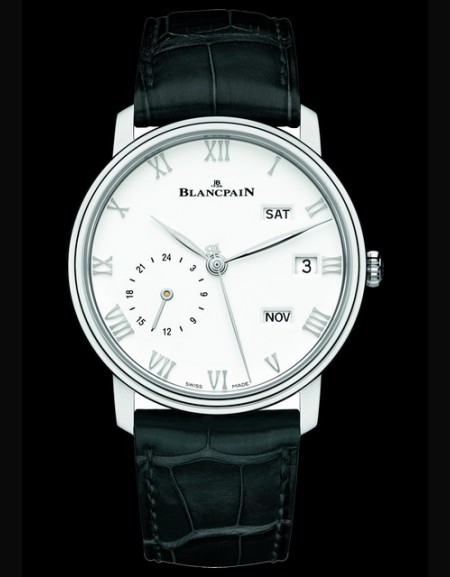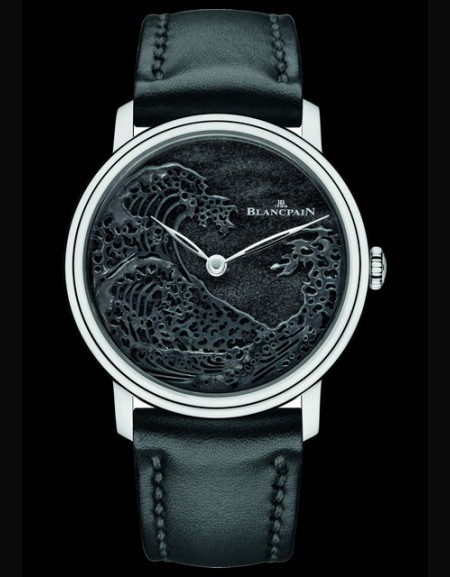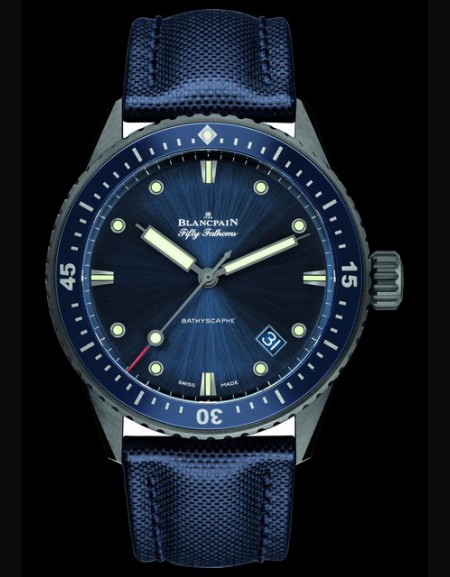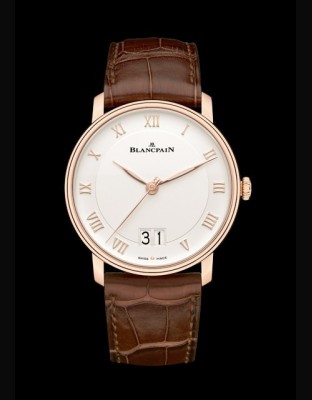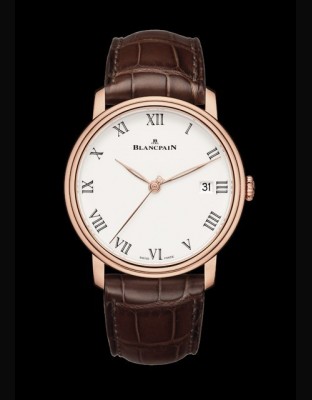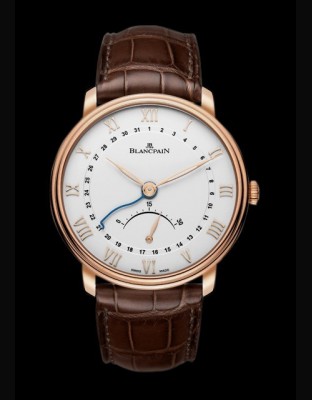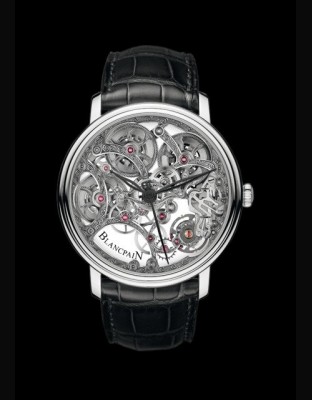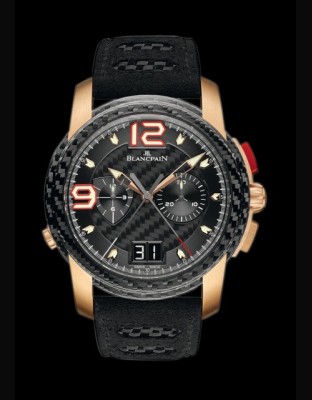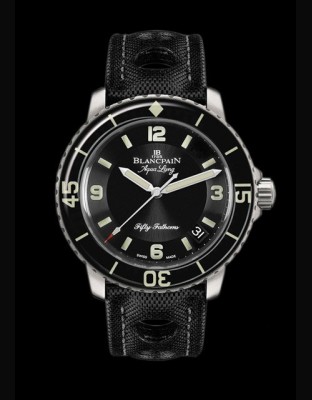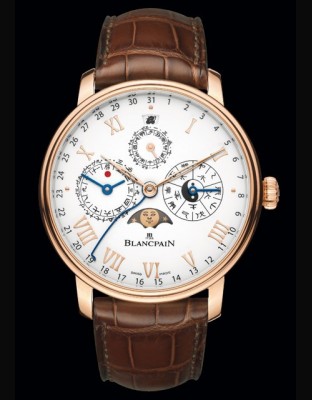1
blancpain

|
||
Blancpain History
1735 : Establishment of the first Blancpain manufacture as a cottage industry by Jehan-Jacques Blancpain.
The initial decision to enter the promising watchmaking trade was Jehan-Jacques Blancpain's. He perceived perhaps more clearly than others the advantages which this new activity offered. There is little doubt that by 1735, for instance, the first floor of his house in the village of Villeret, still standing today, served as a watchmaking workshop. The venture owed its rapid rise to success at least in part to its genero...

THE COLLECTIONS

-
Blancpain Quantième Complet
SEE THE DATA SHEETBrand: Blancpain
Collection: Villeret
Ref: 6654A-3653-55B
Price: ON REQUEST -
Blancpain Extraplate
SEE THE DATA SHEETBrand: Blancpain
Collection: Villeret
Ref: 6651-3653-55B
Price: ON REQUEST -
Blancpain Quantième Phase...
SEE THE DATA SHEETBrand: Blancpain
Collection: Villeret
Ref: 6126-2953-55B
Price: ON REQUEST -
Blancpain Tourbillon...
SEE THE DATA SHEETBrand: Blancpain
Collection: Villeret
Ref: 2322-3653-55B
Price: ON REQUEST -
Fifty Fathoms 70th...
SEE THE DATA SHEETBrand: Blancpain
Collection: Fifty Fathoms
Ref: 5019 12B30 64A
Price: 28 700 € -
Fifty Fathoms Bathyscaphe...
SEE THE DATA SHEETBrand: Blancpain
Collection: Fifty Fathoms
Ref: 5052-1146-E52A
Price: 11 880 € -
Fifty Fathoms Bathyscaphe...
SEE THE DATA SHEETBrand: Blancpain
Collection: Fifty Fathoms
Ref: 5200-0153-NABA
Price: 15 970 € -
Fifty Fathoms Bathyscaphe...
SEE THE DATA SHEETBrand: Blancpain
Collection: Fifty Fathoms
Ref: 5200-0153-B52A
Price: 15 970 € -
Fifty Fathoms Grande Date
SEE THE DATA SHEETBrand: Blancpain
Collection: Fifty Fathoms
Ref: 5050-12B30-98B
Price: 18 760 € -
Fifty Fathoms Automatique
SEE THE DATA SHEETBrand: Blancpain
Collection: Fifty Fathoms
Ref: 5015-12B40-98B
Price: 17 070 € -
Fifty Fathoms Automatique
SEE THE DATA SHEETBrand: Blancpain
Collection: Fifty Fathoms
Ref: 5015-12B30-98B
Price: 17 070 € -
Fifty Fathoms Automatique
SEE THE DATA SHEETBrand: Blancpain
Collection: Fifty Fathoms
Ref: 5015-12B30-B52A
Price: 14 670 € -
Fifty Fathoms Barakuda
SEE THE DATA SHEETBrand: Blancpain
Collection: Fifty Fathoms
Ref: 5008B-1130-B52A
Price: 13 180 € -
Fifty Fathoms Nageur de...
SEE THE DATA SHEETBrand: Blancpain
Collection: Fifty Fathoms
Ref: 5015E-1130-B52A
Price: 14 470 € -
Air Command
SEE THE DATA SHEETBrand: Blancpain
Collection: Specialities
Ref: AC01-1130-63A
Price: 18 460 € -
Villeret Grande Date Jour...
SEE THE DATA SHEETBrand: Blancpain
Collection: Villeret
Ref: 6668-3642-55B
Price: ON REQUEST -
Fifty Fathoms Grande Date
SEE THE DATA SHEETBrand: Blancpain
Collection: Fifty Fathoms
Ref: 5050-12B30-B52A
Price: 16 370 € -
Fifty Fathoms Bathyscaphe...
SEE THE DATA SHEETBrand: Blancpain
Collection: Fifty Fathoms
Ref: 5071-1110-B52A
Price: ON REQUEST -
Fifty Fathoms Bathyscaphe...
SEE THE DATA SHEETBrand: Blancpain
Collection: Fifty Fathoms
Ref: 5052-1110-63A
Price: 11 880 € -
Villeret Quantième Annuel...
SEE THE DATA SHEETBrand: Blancpain
Collection: Villeret
Ref: 6670-1127-55B
Price: 25 450 € -
Villeret 8 jours Manuelle...
SEE THE DATA SHEETBrand: Blancpain
Collection: Villeret
Ref: 6612-3433-63AB
Price: 159 700 € -
Fifty Fathoms Bathyscaphe
SEE THE DATA SHEETBrand: Blancpain
Collection: Fifty Fathoms
Ref: 5000-0240-O52A
Price: 11 980 € -
Villeret Grande Date
SEE THE DATA SHEETBrand: Blancpain
Collection: Villeret
Ref: 6669-3642-55B
Price: 19 860 € -
Villeret 8 Jours
SEE THE DATA SHEETBrand: Blancpain
Collection: Villeret
Ref: 6630-3631-55B
Price: 22 800 € -
Fifty Fathoms Bathyscaphe
SEE THE DATA SHEETBrand: Blancpain
Collection: Fifty Fathoms
Ref: 5000-1110-B52 A
Price: 9 780 € -
Villeret Ultraplate...
SEE THE DATA SHEETBrand: Blancpain
Collection: Villeret
Ref: 6653Q-3642-55B
Price: 17 790 € -
Villeret Squelette 8 Jours
SEE THE DATA SHEETBrand: Blancpain
Collection: Villeret
Ref: 6633-1500-55B
Price: 54 030 € -
L-evolution Chronographe...
SEE THE DATA SHEETBrand: Blancpain
Collection: L-evolution
Ref: 8886F-3603-52B
Price: 44 040 € -
L-evolution Chronographe...
SEE THE DATA SHEETBrand: Blancpain
Collection: L-evolution
Ref: 8886F-1503-52B
Price: 44 040 € -
Fifty Fathoms 'Tribute to...
SEE THE DATA SHEETBrand: Blancpain
Collection: Fifty Fathoms
Ref: 5015C-1130-52B
Price: 13 130 € -
Villeret Calendrier...
SEE THE DATA SHEETBrand: Blancpain
Collection: Villeret
Ref: 00888-3631-55B
Price: 52 510 € -
Villeret Calendrier...
SEE THE DATA SHEETBrand: Blancpain
Collection: Villeret
Ref: 00888-3431-55B
Price: 69 450 €
Blancpain History
1735 : Establishment of the first Blancpain manufacture as a cottage industry by Jehan-Jacques Blancpain.
The initial decision to enter the promising watchmaking trade was Jehan-Jacques Blancpain's. He perceived perhaps more clearly than others the advantages which this new activity offered. There is little doubt that by 1735, for instance, the first floor of his house in the village of Villeret, still standing today, served as a watchmaking workshop. The venture owed its rapid rise to success at least in part to its generous policy with respect to apprenticeships. Jehan-Jacques and his successors always saw it as their duty to pass on their craft know-how to the next generation.
As the years passed, Jehan-Jacques Blancpain worried about his succession. While his son Isaac did occasionally work with his father, he wanted to continue teaching school. But the company's steadily growing success called for someone fully committed to the business - Isaac's son David-Louis, born on December 21, 1765, fitted the bill. He joined the company late in the century, delivering Blancpain watches to customers in neighbouring countries. Whenever the workshops had turned out six dozen watches, he would set off to sell them in the cities and towns of France and Germany.
1815 : David-Louis Blancpain's eldest son Frédéric-Louis had himself become a practicing watchmaker. He would gradually turn the company from a craft-based operation into a full-fledged industrial venture. It was by then making some of its own movement blanks, and was thus an integrated "manufacture". Over the years, more and better machine tools enabled Blancpain to develop its production and steadily improve product quality.
1830 : Frédéric-Louis turned the business over to his 19-year-old son, Frédéric-Emile. To avoid any confusion with his father, the young man began using his second given name only, and the company's style became "E. Blancpain". After Frédéric-Emile's death in 1857, his son Jules-Emile, Nestor and Paul-Alcide became partners in a company now called "E. Blancpain & Fils". Trained as a watchmaker in Switzerland and abroad, Jules-Emile took over management of the company.
In those days, traditional piecework was still being practiced in the farmhouses of the area although batch production had already led to some division of labour. But bitter competition and pressure on prices foreshadowed radical change. In Switzerland as everywhere, there was no denying that the machine age had arrived, with its demand for ever greater precision and output. So in the late 19th century Blancpain set about building a two-story factory on the River Suze to harness its hydraulic energy to drive a generator providing electric power to workshops and machine tools.
30's - 60's : Launch by Blancpain of Leon Hatotes rectangular 'Rolls', an automatic wristwatch using 'roller winding', whereby the movement could move back and forth in the case - a revolutionary idea at that time.
Before the First World War, Frédéric-Emile Blancpain (the second to bear that name) turned the company toward the future - that of the wristwatch. In the early 30s, he made Blancpain enter the annals of automatic wristwatches by launching Léon Hatot's rectangular 'Rolls', an automatic wristwatch using 'roller winding', whereby the movement could move back and forth in the case - a revolutionary idea at that time.
But his unexpected death in 1932 ended two centuries of Blancpain family management, a saga extending over seven generations. As Frédéric-Emile's only child, his daughter Berthe-Nellie, had no desire to carry on, in June 1933 the firm passed to her father's closest assistant, Betty Fiechter, and her associate, André Léal. They acquired its assets and liabilities and continued the business under the name "Rayville Ltd. [anagram of Villeret], successors to Blancpain". In the early 50s, Betty Fiechter and her team launched the diver's automatic 'Fifty Fathoms" wristwatch and the first Ladybird whose presentation in 1956 caused a sensation in watch circles: its tiny round movement was the smallest of its generation.
Rayville-Blancpain remained to some considerable extent a craft operation, turning out a few thousand watches a year by traditional methods. But as it lacked marketing resources, its future was uncertain. Despite this situation, or perhaps because of it, it decided to accept the protection of a major watch-industry holding company set up in 1930, called SSIH (Swiss Watch Industry Corporation Ltd.).
1953 : Worn by Jacques-Yves Cousteau and his team during the shoot of 'The World of Silence' (Palme d'Or at Cannes in 1956), Blancpaines Fifty Fathoms was also selected for its technical superiority by several armies (among others: US, French, German and Italian).
1956 : Launch of the Ladybird model, the smallest automatic movement in the world.
1971 : A new management team at SSIH decided on a radical change in business and industrial strategy that had no use for mechanical niche products. Since Blancpain lacked the brand awareness needed to survive as a marketer of "me too" quartz products, it soon disappeared from the market. In hindsight, this proved a blessing in disguise. Like Sleeping Beauty, Blancpain sank into a deep sleep.
1983 : At a moment when the Swiss watch industry was betting everything on quartz and beginning to destroy its production equipment and, in part, the culture of the mechanical watch, Jean-Claude Biver and Jacques Piguet, who agreed that traditional mechanical watches still possessed a surprising and indeed highly promising lease on life, combined forces on January 9, 1983, to revive the Blancpain Company two and a half centuries after its foundation. Close scrutiny of all available records confirmed to Jean-Claude Biver that there never had been such a thing as a Blancpain quartz watch. And none will exist in the future. Jacques Piguet, the son of Frédéric Piguet, the reputed maker of rough movements, or blanks, stood ready to contribute his very considerable expertise.
Many specialists were predicting the death of the mechanical watch due to the arrival of quartz. The traditional watchmaker's art and know-how was rapidly falling into decline, and as the former Blancpain workshops in Villeret had been taken over by Omega, the two men decided to relocate Blancpain wherever craft traditions were still vigorously upheld. They finally settled on the Vallée de Joux, in the Jura mountain range of western Switzerland, a centre of fine watchmaking since the mid-1700s and today still the birthplace of 90% of all high-end mechanical complications. Here, in a village called Le Brassus, stands a fine old Piguet family house, inhabited by the very soul of watchmaking - just the place for Blancpain's new home. It would now turn out watches made in the most genuinely traditional manner, similar in spirit to those that Jehan-Jacques Blancpain and his descendants fashioned more than two centuries ago some one hundred kilometres away.
Vital watchmaking information and secrets were saved just in time, treasures from the past that had not yet been destroyed or set aside. At Frédéric Piguet's in the Vallée de Joux, a large number of old movements were found for which there were no plans at all. After studying them individually, plans were created for each of these movements. By turning to the past to relive the beginnings of watchmaking as it existed among the isolated farms of the Jura, Blancpain was able to allow the culture of mechanical watchmaking to endure, as well as the traditional watchmaker's art of the region and of an entire country.
1983 : A world first: the smallest movement indicating moon phase, day, month and date.
1987 : Launch of The World's Thinnest Automatic Chronograph. Launch of The world's Smallest Minute repeater Wristwatch.
1988 : Launch of The World's Thinnest Split-Second Chronograph.
1989 : Another world premiere: the first and only thinnest self-winding Tourbillon watch with date and one-week power reserve.
1991 : Blancpain presents simultaneously all six masterpieces of the watchmaker's art housed in identical cases. And finally, marking watchmaking history, the 1735 including all six masterpieces in a single watchcase the most complicated wristwatch
ever made.
1993 : To celebrate the 300th birthday of its founder, Jehan-Jacques Blancpain, the company in Le Brassus created the 7001 watch. Launch of The World's First Wristwratch Repeater with Automata.
1994 : Launch of the 2100 watch (Leman collection today) whose screw-locked case back and pushpieces ensure water-resistance to 100 meters, a perfect companion for the ceaseless drive and mobility of the women and men of today.
1995 : An all-time record year: the watches of the 2100 sports line (Leman collection today) were named 'Watches of the Year' for 1995-96.
1996 : Blancpain develops the new 100-hours movement for adaptation on all models of the 2100 collection (Leman collection today) (moon phase, extra-slim, perpetual calendar). Launch of the flyback chronograph.
1997 : Blancpain is the first brand to bring out a ladies chronograph with flyback hand. Creation of the new self-winding Ladybird watch, housing a tiny automatic movement, the smallest and the slimmest in the world.
1998 : Launch of the Sea Earth Sky trilogy including the Fifty Fathoms, the GMT and the Air Command. Launch of The World's First Automatic Tourbillon with 8 Days Power Reserve.
1999 : A World's First Combination of Tourbillon and Chronograph Complications.
2000 : Launch of The World's First Perpetual Calendar Tourbillon with 8 Days Power Reserve.
2001 : The ladies watch prize of Geneva's first Watchmaking Grand Prix was awarded to Blancpain's flyback pastel chronograph (ref. 2385F-192GC-52).
2002 : The ladies watch prize of La Revue des Montres was awarded to Blancpain's self-winding flyback chronograph (ref. 2385-1127). The ultra-slim, Villeret, self-winding (ref. 4053-1540-55) was recognised 'Watch of the Year' by the Swiss public. In Austria, the Luxus prize of the Chrono Awards and the men's watch prize of the press were awarded to Blancpain's ultra-slim, Villeret, self-winding (ref. 4063-3642-55).
2003 : Revival of the Moon Phase and the World's Smallest Calendar Moon Phase Plate.
2004 : Launch of The World's First Equation Marchante Wristwatch.
2005 : The World's First Hidden Calendar Correctors. Launch of the First Perpetual Calendar with correctors under the lugs. Launch of The World's Thinnest Perpetual Calendar.
2007 : Creation of Blancpain Calibre 13R0. The Dawn of a New Era.
2008 : Launch of The World's First Carrousel Volant Une Minute.
